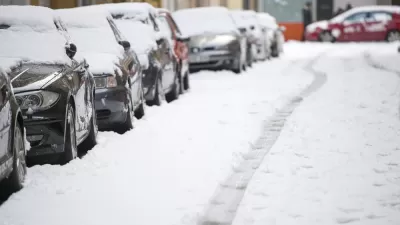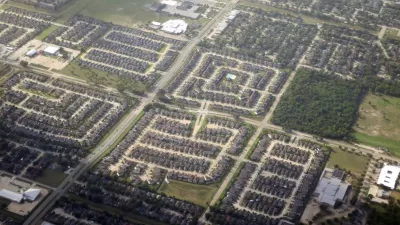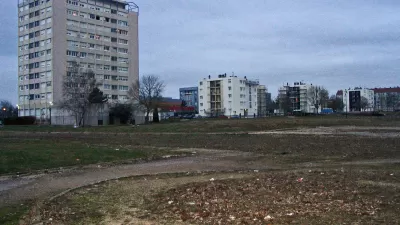American suburbs are growing, and understanding the evolution of suburban sprawl is a useful guide for the future.

[Updated 11/19/2018] In a piece written for his new book, “The Urban Fix: Resilient Cities in the War against Climate Change, Heat Islands and Overpopulation,” Doug Kelbaugh reflects on the history of suburban sprawl and the challenges its continued growth brings.
Kelbaugh isn’t a fan of suburbs — he refers to suburbia as a virus — and he draws from the writings of various academics and journalists to look back at the spread of modern suburbs in the United States, starting after World War II. Suburbs were not only heavily subsidized notions of the American Dream, says Kelbaugh; they were also an attack on nature. “It’s tragic that America not only smeared the suburban compromise of town and country across its 50 states, but it also exported it a world only too happy to embrace the seemingly happy lifestyle they’d seen in the movies and on TV,” he laments.
He continues through the many problems with suburbs. They are unsustainable by encouraging auto dependence, low density, big houses, and environmentally unfriendly lawns. The architecture is soulless. The parking lots are expansive. The intersections are too big. “This is the land of big asphalt, which absorbs solar radiation and creates heat islands even in low-density suburbia,” Kelbaugh notes.
But while cities offer more of what millennials want, they still are moving to the suburbs. Kelbaugh, however, thinks millennials will drive the transformation of suburbs with their desire for more sustainable communities:
Drone deliveries, ride-sharing, car-sharing, AVs that park themselves and connect to house lights and thermostats will be commonplace, as will up to a 50 percent reduction in paved area. Less hardscape won’t be difficult, given the absurdly wide streets in contemporary subdivisions. There will be fewer fences and more common land for recreation, gardens, ponds, woods and wetlands.
The environmental issues with suburbs — the heat, the consumption of precious resources, the air pollution — make reining them in a global concern, says Kelbaugh. Particularly in developing countries with fast-growing metropolises, he believes containing sprawl is imperative in maintaining the quality of life of residents in highly populated areas.
FULL STORY: Reconfronting sprawl: Still paved with good intentions and asphalt

Alabama: Trump Terminates Settlements for Black Communities Harmed By Raw Sewage
Trump deemed the landmark civil rights agreement “illegal DEI and environmental justice policy.”

Planetizen Federal Action Tracker
A weekly monitor of how Trump’s orders and actions are impacting planners and planning in America.

The 120 Year Old Tiny Home Villages That Sheltered San Francisco’s Earthquake Refugees
More than a century ago, San Francisco mobilized to house thousands of residents displaced by the 1906 earthquake. Could their strategy offer a model for the present?

In Both Crashes and Crime, Public Transportation is Far Safer than Driving
Contrary to popular assumptions, public transportation has far lower crash and crime rates than automobile travel. For safer communities, improve and encourage transit travel.

Report: Zoning Reforms Should Complement Nashville’s Ambitious Transit Plan
Without reform, restrictive zoning codes will limit the impact of the city’s planned transit expansion and could exclude some of the residents who depend on transit the most.

Judge Orders Release of Frozen IRA, IIJA Funding
The decision is a victory for environmental groups who charged that freezing funds for critical infrastructure and disaster response programs caused “real and irreparable harm” to communities.
Urban Design for Planners 1: Software Tools
This six-course series explores essential urban design concepts using open source software and equips planners with the tools they need to participate fully in the urban design process.
Planning for Universal Design
Learn the tools for implementing Universal Design in planning regulations.
Clanton & Associates, Inc.
Jessamine County Fiscal Court
Institute for Housing and Urban Development Studies (IHS)
City of Grandview
Harvard GSD Executive Education
Toledo-Lucas County Plan Commissions
Salt Lake City
NYU Wagner Graduate School of Public Service





























